
The clarinet is a family of woodwind instruments. It has a single-reed mouthpiece, a straight, cylindrical tube with an almost cylindrical bore, and a flared bell. A person who plays a clarinet is called a clarinetist.
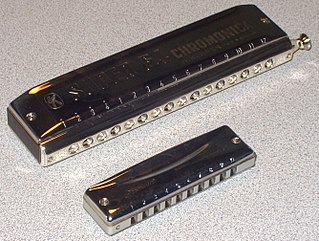
The harmonica, also known as a French harp or mouth organ, is a free reed wind instrument used worldwide in many musical genres, notably in blues, American folk music, classical music, jazz, country, and rock. The many types of harmonica include diatonic, chromatic, tremolo, octave, orchestral, and bass versions. A harmonica is played by using the mouth to direct air into or out of one holes along a mouthpiece. Behind each hole is a chamber containing at least one reed. A harmonica reed is a flat, elongated spring typically made of brass, stainless steel, or bronze, which is secured at one end over a slot that serves as an airway. When the free end is made to vibrate by the player's air, it alternately blocks and unblocks the airway to produce sound.

A percussion instrument is a musical instrument that is sounded by being struck or scraped by a beater including attached or enclosed beaters or rattles struck, scraped or rubbed by hand or struck against another similar instrument. Excluding zoomusicological instruments and the human voice, the percussion family is believed to include the oldest musical instruments.

Woodwind instruments are a family of musical instruments within the more general category of wind instruments. Common examples include flute, clarinet, oboe, saxophone, and bassoon. There are two main types of woodwind instruments: flutes and reed instruments. The main distinction between these instruments and other wind instruments is the way in which they produce sound. All woodwinds produce sound by splitting the air blown into them on a sharp edge, such as a reed or a fipple. Despite the name, a woodwind may be made of any material, not just wood. Common examples include brass, silver, cane, as well as other metals such as gold and platinum. The saxophone, for example, though made of brass, is considered a woodwind because it requires a reed to produce sound. Occasionally, woodwinds are made out of earthen materials, especially ocarinas.

A reed is a thin strip of material that vibrates to produce a sound on a musical instrument. Most woodwind instrument reeds are made from Arundo donax or synthetic material. Tuned reeds are made of metal or synthetics. Musical instruments are classified according to the type and number of reeds.
A slide whistle is a wind instrument consisting of a fipple like a recorder's and a tube with a piston in it. Thus it has an air reed like some woodwinds, but varies the pitch with a slide. The construction is rather like a bicycle pump. Because the air column is cylindrical and open at one end and closed at the other, it overblows the third harmonic. "A whistle made out of a long tube with a slide at one end. An ascending and descending glissando is produced by moving the slide back and forth while blowing into the mouthpiece." "Tubular whistle with a plunger unit in its column, approximately 12 inches long. The pitch is changed by moving the slide plunger in and out, producing ascending and descending glisses."

Throughout history, various methods of musical instrument classification have been used in organology. The most commonly used system divides instruments into string instruments, woodwind instruments, brass instruments and percussion instruments; however, other schemes have been devised.
Hornbostel–Sachs or Sachs–Hornbostel is a system of musical instrument classification devised by Erich Moritz von Hornbostel and Curt Sachs, and first published in the Zeitschrift für Ethnologie in 1914. An English translation was published in the Galpin Society Journal in 1961. It is the most widely used system for classifying musical instruments by ethnomusicologists and organologists. The system was updated in 2011 as part of the work of the Musical Instrument Museums Online (MIMO) Project.
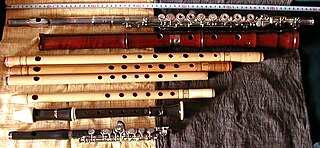
An aerophone is a musical instrument that produces sound primarily by causing a body of air to vibrate, without the use of strings or membranes, and without the vibration of the instrument itself adding considerably to the sound.
Overblowing is a technique used while playing a wind instrument that causes the sounded pitch to jump to a higher one primarily through the manipulation of the supplied air rather than by a fingering change or the operation of a slide. Depending on the instrument, and to a lesser extent the player, overblowing may involve a change in the air pressure, in the point at which the air is directed, or in the resonance characteristics of the chamber formed by the mouth and throat of the player. In some instruments, overblowing may also involve the direct manipulation of the vibrating reed(s), and/or the pushing of a register key while otherwise leaving fingering unaltered. With the exception of harmonica overblowing, the pitch jump is from one vibratory mode of the reed or air column, e.g., its fundamental, to an overtone. Overblowing can be done deliberately in order to get a higher pitch, or inadvertently, resulting in the production of a note other than that intended.
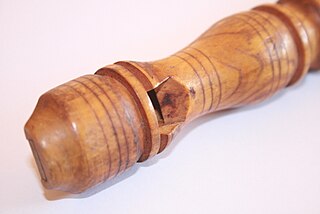
A fipple is a constricted mouthpiece common to many end-blown flutes, such as the tin whistle and the recorder. These instruments are known as fipple flutes and are indicated by the code 421.2 in the Hornbostel–Sachs classification.

A flue pipe is an organ pipe that produces sound through the vibration of air molecules, in the same manner as a recorder or a whistle. Air under pressure is driven through a flue and against a sharp lip called a labium, causing the column of air in the pipe to resonate at a frequency determined by the pipe length. Thus, there are no moving parts in a flue pipe. This is in contrast to reed pipes, whose sound is driven by beating reeds, as in a clarinet. Flue pipes are common components of pipe organs.

A pipe is a tubular wind instrument in general, or various specific wind instruments. The word is an onomatopoeia, and comes from the tone which can resemble that of a bird chirping.
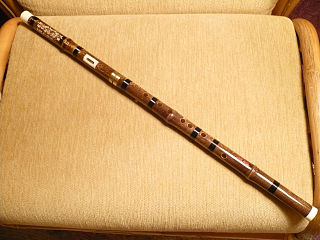
The bawu is a Chinese wind instrument. Although shaped like a flute, it is actually a free reed instrument, with a single metal reed. It is played in a transverse (horizontal) manner. It has a pure, clarinet-like timbre and its playing technique incorporates the use of much ornamentation, particularly bending tones.
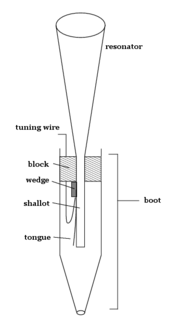
A reed pipe is an organ pipe that is sounded by a vibrating brass strip known as a reed. Air under pressure is directed towards the reed, which vibrates at a specific pitch. This is in contrast to flue pipes, which contain no moving parts and produce sound solely through the vibration of air molecules. Reed pipes are common components of pipe organs.

A hydraulophone is a tonal acoustic musical instrument played by direct physical contact with water where sound is generated or affected hydraulically. The hydraulophone was described and named by Steve Mann in 2005, and patented in 2011. Typically, sound is produced by the same hydraulic fluid in contact with the player's fingers. It has been used as a sensory exploration device for low-vision individuals.

A wind instrument is a musical instrument that contains some type of resonator in which a column of air is set into vibration by the player blowing into a mouthpiece set at or near the end of the resonator. The pitch of the vibration is determined by the length of the tube and by manual modifications of the effective length of the vibrating column of air. In the case of some wind instruments, sound is produced by blowing through a reed; others require buzzing into a metal mouthpiece, while yet others require the player to blow into a hole at an edge, which splits the air column and creates the sound.

There are several overlapping schemes for the classification of percussion instruments.













